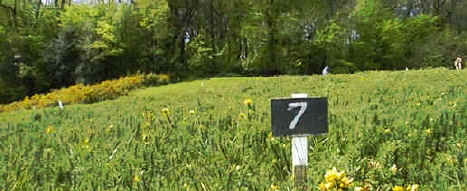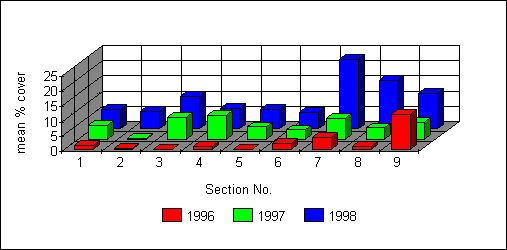|
The
Woodland Education Centre |
|
|
The
Woodland Education Centre |
|
Ecological Surveys 1996 - 1998
The Effects of Management
Grass & Gorse Control.

| The initial application
of Kerb Granules to section 7 for specific grass control, prevented grasses from becoming
dominant in this section in 1996 and 1997 (Table).
However, by 1998 grasses were increasing in dominance. Common Bent (Agrostis capillaris) rather than Yorkshire Fog (Holcus lanatus) was the dominant grass in this section in 1998. Sedges (Cyperus spp.) were spreading gradually over the whole site, but had a comparatively high % cover in section 7 (Figure below). This may be related to the decreased competition with grasses for space in this section. However, It may also be that this northern area of the site is wetter than the other areas, because sedges (which tend to favour wetter conditions) were more prominent in all of sections 7 - 9. |

The Distribution of Sedges (Cyperus spp.) 1996-1998
Gorse Control
While these results indicate greatly decreased gorse cover in section 7, this is misleading, as gorse was actually still distributed over fairly large areas in this section. The gorse, while widespread, did not uniformly cover the area and was most abundant in the lower, eastern end of the section. (This is an illustration of a phenomenon noticed many times while sampling. Namely that the vegetation of the upper, western end of the project site was often markedly different to the lower, eastern end. This is most likely to be due to the influence of the woodland on the western border of the project site, as well as to the sloping gradient.) A number of the random samples (being truly random) fell several times in areas which were not covered by gorse. This resulted in a lowering of the mean % cover value for gorse overall. This is a consequence of the patchy distribution of the gorse and is an example of a case where more samples would undoubtedly have led to a truer picture of the area. A visual examination of section 7 quickly indicates that the initial single spot spraying session with Garlon to control the gorse was largely unsuccessful, despite the contrary indications of the survey results.
The Effects of using Roundup Roundup was used in both sections 8 and 9 initially, to remove species which might compete with the Heather. While Heather was extremely well-established in section 9 by 1998, there was a correspondingly low % cover of Heather in section 8 (Heather Distribution). The use of Roundup does not therefore appear to have had any significant promotional effect on heather establishment. The use of Roundup resulted in a significantly lowered species diversity in section 8 initially (Chart). This effect was not noted in section 9. This may be accounted for by the fact that section 9 is likely to be much more diverse than section 8 to begin with, because it covers a much larger, more environmentally diverse area.
|
Continue to Bracken
Ecological Surveys 96 - 98 |